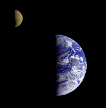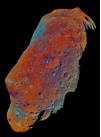SwRI Science Directorate
SwRI’s Space Directorate conducts basic observational, modeling, and theoretical research in a wide range of solar system and astrophysical topics. The Space Mission Directorate is active in the development and operation of a wide array of instrumentation and several space missions. Our directorates are located at the base of the Rocky Mountains in Boulder, Colorado, and the office hosts a steady stream of international visiting scientists and engineers, and organizes workshops and meetings with focused scientific and space exploration topics.
Origins Research

One of our most integrated areas of research is in solar system origins. This field includes the study of the formation of our solar system, andthe origin, structure, and detection of planetary systems around other stars. Much of our origins research involves high-performance computing and numerical modeling, utilizing our super-computing clusters. Particular research topics include studies of the origin of the Moon, planet formation, the dynamics andcontent of the Oort Cloud and Kuiper belt (primordial reservoirs of comets and minor planets beyond the orbit of Neptune), the late heavy bombardment, modern Earth impact hazards, and the properties and origin of Pluto, Triton, and the Centaurs. Science Directorate researchers also study surface processes and dynamical evolution of asteroids, the composition and activity of cometary comae, and the structure and dynamics of the solar nebula.
Planetary Astronomy

Science Directorate researchers explore the planets, moons, asteroids, andcomets using a wide variety of international space- and ground-based observatories (including the use of adaptive optics), and are active in related theoretical modeling. Planetary topics of interest include the dynamics andphysical properties of solar system bodies and planetary rings (the systems of orbiting debris girdling the outer planets), occultations, Martian polar obliquity cycles, and cratering and catastrophic collisions. Science Directorate scientists have conducted searches for evidence of lunar polar water, Vulcanoids (the long-suspected population of minor planets inside the orbit of Mercury), and have detected asteroidal satellites.
Solar Physics

We couple data analysis and modeling work with a cutting edge hardware program to develop new instrumentation for both space-based and ground-based solar physics. Using data from the Solar and Heliospheric Observatory (SoHO) spacecraft, Institute scientists study the dynamics of the Sun’s atmosphere, producing the first velocity maps of the solar wind coming from coronal holes, and the highest quality magnetic maps ever made of the Sun’s polar regions. A nin-depth analysis of the relationship between the magnetic field and the million degree plasma in the solar corona uses a technique called “fluxon relaxation”, a ground-breaking, SwRI-developed modeling method for extrapolating magnetic fields to solve problems that are inaccessible to more conventional techniques.The Solar Physics section also has an active NASA sounding rocket program to develop new technology for future satellite missions, including a next generation, fast, high resolution imaging spectrograph to study wave motions and turbulent flow in the Sun’s ultrahot atmosphere.
Planetary Atmospheres

Our ongoing research programs address the dynamics, energetics, composition, chemistry, structure, origin, evolution, and variability of planetary atmospheres. Science Directorate expertise includes the atmospheres and exospheres of Mars, Mercury, Venus, the Moon, Io, Titan, Chiron, Triton, Pluto, and the Jovian planets. Our group also makes significant contributions in thearea of cometary atmospheres, with both ground and space-based observations, and theoretical modeling.
Geophysics

We seek to understand the interior structures, compositions, and dynamics of solid planets and Moons. Science Directorate scientists are team members of the orbital ground-penetrating radars currently mapping Mars. We are developing avariety of electromagnetic-sounding tools for future exploration, particularly for groundwater on Mars and ground ice on the Moon. To support mission planning and data analysis, the Planetary Electrical Properties and Geochemistry Laboratory performs dielectric and infrared spectroscopy over a wide range of physical conditions relevant to planetary environments. Numerical modeling of groundwater flow on Mars and solid-state convection in the icy shells of the outer-planet moons provides the theoretical complement to our observational and laboratory studies.
Astrophysics

Active research in this area includes observational and modeling studies of hot stars, variable stars, binary stars, stellar pulsations, star formation and evolution, the interstellar medium, and dust accretion in extrasolar disks. Observational multi-wavelength programs in the department make use of large ground-based telescopes and space-based instruments.
Solar System Exploration
The Science and Mission Directorates participate in solar system exploration through involvement in NASA orbital and deep space missions, ground-based optical and radio observations, and basic modeling and theoretical research. Science Directorate scientists have been team members on many space missions such as: New Horizons (Pluto), Mars Science Laboratory (Mars), Cassini (Saturn), Galileo (Jupiter), Lucy (Jovian trojans), Messenger (Mercury), Rosetta (comet rendezvous), NEAR (asteroid rendezvous), the Lunar Reconnaissance Orbiter (Moon), and the Cosmic Origins Spectrograph aboard the Hubble Space Telescope. Division researchers also have designed and conducted Space Shuttle, airborne, balloon, and sounding rocket experiments with instruments built by SwRI.